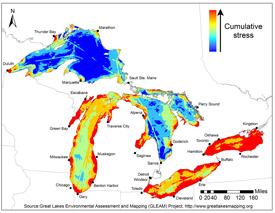The Great Lakes are at risk of “death by a thousand cuts,” according to a University of Windsor biologist who was part of an international team of scientists who spent three years identifying the worst threats to one of the world’s largest supplies of fresh water.
“The lakes face many different problems that would not necessarily be fatal on their own, but they can combine to create major declines in ecosystem condition,” said Jan Ciborowski, one of only two Canadian scientists who contributed to an environmental stress map developed by the Great Lakes Environmental Assessment and Mapping (GLEAM) Project.
The team, led by a group at the University of Michigan, created a comprehensive map that identifies 34 of the greatest stressors the lakes are facing, including coastal development, pollutants transported by rivers from agricultural and urban land, fishing pressure, climate change, invasive species and toxic chemicals. Their findings were reported in an article published yesterday in the Proceedings of the National Academy of Sciences.
"Basically, our work itemizes the laundry list of things that need to be fixed and where they occur," said  co-author Peter McIntyre, a professor at the University of Wisconsin-Madison’s Center for Limnology. "This information can be used in any given location by local officials and citizen groups."
co-author Peter McIntyre, a professor at the University of Wisconsin-Madison’s Center for Limnology. "This information can be used in any given location by local officials and citizen groups."
To rank the relative importance of those 34 stressors to ecosystem health, the team surveyed 161 researchers and natural resource managers from across the Great Lakes basin. Dr. Ciborowski’s contribution involved identifying stressors from the rivers flowing into the Great lakes and their watershed areas and comparing them to biological conditions at the shorelines of the lakes. His work helped classify watersheds that were having the greatest impact on the lakes through such threats as agricultural run-off and urban development.
According to the report, ecosystem stress is highest closer to shores, but also extends offshore in some areas. Large sub-regions of moderate to high cumulative stress were found in lakes Erie and Ontario as well as in Saginaw and Green Bays, and along Lake Michigan’s shorelines. In contrast, extensive offshore areas of lakes Superior and Huron, where the coasts are less populated and developed, experience relatively low stress.
Ciborowski said he hopes the information will help environmental managers and law makers protect critical natural resources.
“A picture is worth a thousand words,” said Ciborowski, “These maps show very clearly where some of the most serious problems are and this should help us identify the areas where we need to concentrate our efforts for both preservation and restoration.”

